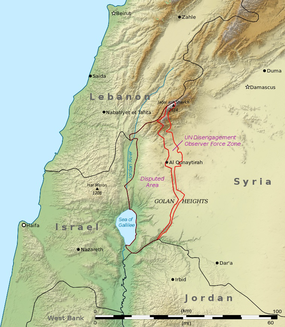Gamla
| גמלא | |

The acropolis of Gamla
|
|
| Location | Golan Heights, controlled by Israel |
|---|---|
| Coordinates | 32°54′10″N 35°44′26″E / 32.90278°N 35.74056°ECoordinates: 32°54′10″N 35°44′26″E / 32.90278°N 35.74056°E |
| Type | Fortification and settlement |
| History | |
| Material | Basalt |
| Founded | 3rd century BC |
| Abandoned | 67 AD |
| Periods | Hellenistic to Roman Empire |
| Site notes | |
| Excavation dates | 1978–2000 |
| Archaeologists | Shmarya Guttman, Danny Sion |
| Management | Israel Nature and Parks Authority |
| Website | Gamla Nature Reserve |
Gamla (Hebrew: גמלא) or Gamala was an ancient Jewish city on the Golan Heights, believed to have been founded as a Seleucid fort during the Syrian Wars. The site of a Roman siege during the Great Revolt of the 1st century CE, Gamla is a symbol of heroism for the modern state of Israel and an important historical and archaeological site. It lies within the current Gamla nature reserve and is a prominent tourist attraction.
Situated at the southern part of the Golan, overlooking the Sea of Galilee, Gamla was built on a steep hill shaped like a camel's hump, from which it derives its name (Gamla meaning 'the camel' in Aramaic). Although the site was inhabited since the Early Bronze Age, the city appears to have been founded as a Seleucid fort during the Syrian Wars (3rd century BCE) which later became a civilian settlement. Jews inhabited it from the last quarter of the 2nd century BCE, and it was annexed to the Hasmonean state under king Alexander Jannaeus in c. 81 BCE.
Josephus Flavius, Commander of Galilee during the Jewish Revolt against Rome, in 66 CE fortified Gamla as his main stronghold on the Golan. Josephus gives a very detailed topographical description of the city, which he also referred to as Gamala, and the steep ravines which precluded the need to build a wall around it. Only along the northern saddle, at the town's eastern extremity, was a 350 meters-long wall built. It was constructed by blocking gaps between existing houses and destroying houses that lay in its way.
Initially loyal to the Romans, Gamla turned rebellious under the influence of refugees from other locations. It was one of only five cities in the Galilee and Golan who stood against Vespasian's legions, reflecting the cooperation between the local population and the rebels. At the time of the revolt, the town minted its own coins, probably more as a means of propaganda than as currency. Bearing the inscription "For the redemption of Jerusalem the H(oly)" in a mixture of paleo-Hebrew (biblical) and Aramaic, only 6 of these coins have ever been found.
...
Wikipedia

